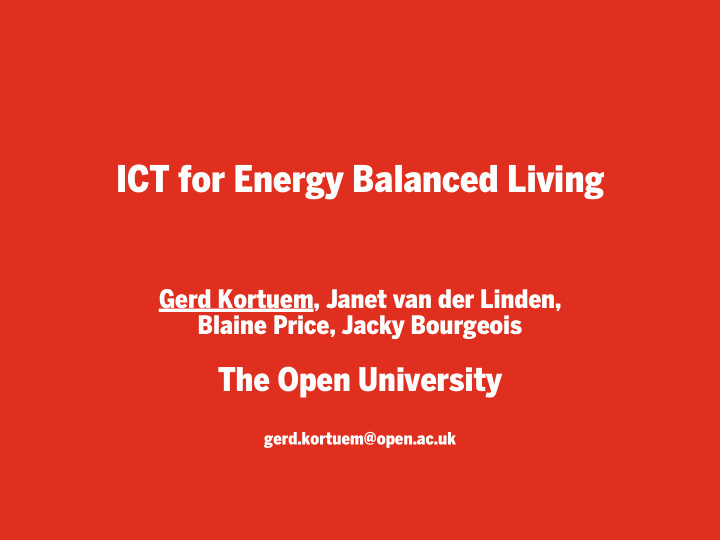



ICT for Energy Balanced Living Gerd Kortuem, Janet van der Linden, Blaine Price, Jacky Bourgeois The Open University gerd.kortuem@open.ac.uk
We will all be ENERGY FARMERS soon ...?
By September 2012 there were over 360,000 domestic microgeneration installations in the UK, with a constant pace of over 1,200 installations added per week. As of March 2012, domestic PV systems registered under the Feed-in Tari ff s reached 800 megawatt, which is about 0.1% of UK domestic electric consumption. [Feed-in Tari ff statistics - Department of Energy and Climate Change: 2012. http:// www.decc.gov.uk/en/content/cms/statistics/energy_stats/source/fits/fits.aspx]
Comprehensive (EV + home Energy is becoming more COMPLEX for consumers
Computer Science is about dealing with complexity
Currently we are just exposing complexity
What is the role of ICT in helping people deal with ENERGY COMPLEXITY? What is the role of ICT in enabling people to live an ENERGY-BALANCED LIVE?
Consumption vs Generation (2013-01-15)
Is DEMAND-SHIFTING a viable option?
Is DEMAND-SHIFTING a viable option?
Map of participant distribution Participant Demographics People in Household No of bedrooms Monthly Energy Cost FOCUS GROUPS with 75 Households – – –
“We now switch on (appliances) when the sun is out – so that’s happened with the introduction of solar panels…” “the sun was out, so the washing machine was on. It would be nice if I could do the ironing – but I don’t know how much …” There is evidence that people do DEMAND SHIFTING
People BELIEVE they understand their own energy generation, but is their understanding correct?
Do they understand the precision required to do e ff ective demand shifting?
Strategy 1: send all local generation to the grid • Export all the local generation • Import all the consumption Strategy 2: use local generation locally, export excess • Use the local generation to power the consumption • When Generation > Consumption then Export • When Generation < Consumption then Import Strategy 3: as Strategy 2 but charge battery with excess • Use the local generation to power the consumption • When Generation > Consumption then Charge the battery first, then export • When Generation < Consumption then Discharge the battery first, then import Strategy 4: as Strategy 3 but also charge battery at night (Economy 7) Do they understand the how import/export works? • Use the local generation to power the consumption • When Generation > Consumption then Charge the battery first, then export • When Generation < Consumption then Discharge the battery first, then import
Do they understand import/export tari ff s?
The current FEEDBACK-based approach is not enough
Recommendation User Interface for DEMAND-SHIFTING
“Now is not a good time for using me.” “In 3 hours there will be enough local energy to run me.” “Would you like me to start in 3 hours?” “You could save £100/year if you follow my advice (or 80kg CO 2 ).” “80% of your neighbours follow my advice, why don’t you?” Recommendation User Interface for DEMAND-SHIFTING
How well can we predict local demand and generation? What are the social constraints for demand shifting? How does the message e ff ect people’s willingness to shift demand? What are the overall savings that can be realized? Recommendation User Interface for DEMAND-SHIFTING
Recommend
More recommend